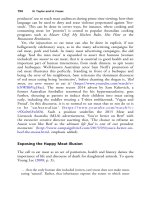The palgrave international handbook of a 490
Bạn đang xem bản rút gọn của tài liệu. Xem và tải ngay bản đầy đủ của tài liệu tại đây (38.06 KB, 1 trang )
492
R. Hediger
and so on—tend to take a similar pattern. No other species wages war like
modern humans do. Even early humans did not.
Recognizing this fact can have direct bearing on the way we write and think
about animals and animal abuse, upsetting commonly accepted views. For
instance, many writers on animals and war adopt a stance of inevitability
about the subject that we can resist. Lemish, for example, though he writes
with compassion and sensitivity regarding animals, and though he notes that he
‘does not glorify combat’ (1996, p. xii), nonetheless resists ‘animal rights
proponents’ and others who would ‘argue that the use of dogs by the military
establishment is nothing more than exploitation’ (x). He notes that ‘a soldier
does not create the conflict he is engaged in’, and therefore resembles the dog
and other animals (xi). While I agree with Lemish’s point about soldiers, this fact
can be used to conclude upon the unjustness of war for nearly all its
participants. Even when human soldiers consent to involve themselves in
a war effort (something animals do not do), rarely can soldiers be said to
know exactly what such consent entails. From that perspective, there
is no entirely rational embrace of war, either for human or nonhuman
animals. Instead, war necessarily involves involuntary, non-rational
decision-making. War requires a form of commitment or compulsion
that places the military unit or organization above the value of the lives
of participants. War is therefore inherently abusive.
But this reality of group effort can be turned to good effect. The conduct
of war relies for its power and horror upon assemblages of tools, animals,
cultures, impacting all of them and the environment more generally (Nixon
2011, pp. 199–232). While this complexity can make it difficult for an
individual to resist war and its horrors, a culture that decides against war can
turn those dynamics the other way around, making peacefulness the reality
difficult to resist, using cooperation and group effort against war, and therefore against animal abuse in it.
References
Alger, J. M., & Alger, S. F. (2013). Canine soldiers, mascots, and stray dogs in U.S.
wars. In R. Hediger (Ed.) Animals and war: studies of Europe and North America
(pp. 77–104). Leiden: Brill.
Anthony, D. W. (2007). The horse, the wheel, and language: how bronze-age riders
from the Eurasian steppes shaped the modern world. Princeton: Princeton
University Press.
Axtell, M. (2009). Bioacoustical Warfare. Minnesota Review, 73/74, 205–218.









